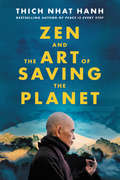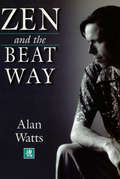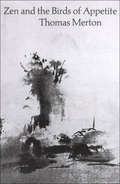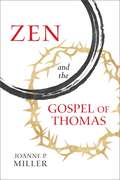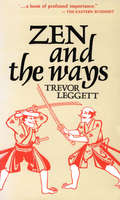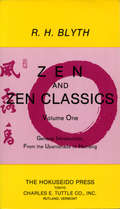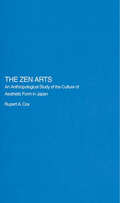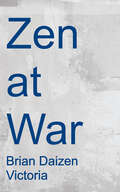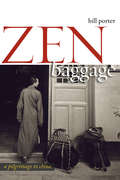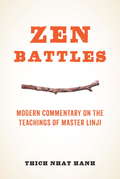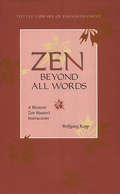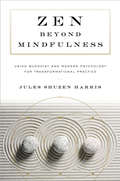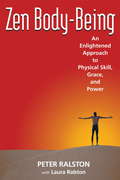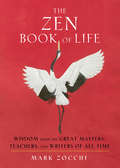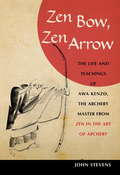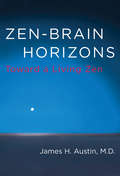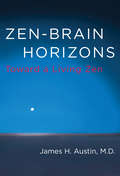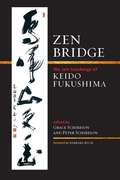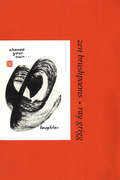- Table View
- List View
Zen and the Art of Saving the Planet
by Thich Nhat Hanh“When you wake up and you see that the Earth is not just the environment, the Earth is us, you touch the nature of interbeing. And at that moment you can have real communication with the Earth… We have to wake up together. And if we wake up together, then we have a chance. Our way of living our life and planning our future has led us into this situation. And now we need to look deeply to find a way out, not only as individuals, but as a collective, a species.”-- Thich Nhat HanhWe face a potent intersection of crises: ecological destruction, rising inequality, racial injustice, and the lasting impacts of a devastating pandemic. The situation is beyond urgent. To face these challenges, we need to find ways to strengthen our clarity, compassion, and courage to act.Beloved Zen Master Thich Nhat Hanh is blazingly clear: there’s one thing we all have the power to change, which can make all the difference, and that is our mind. Our way of looking, seeing, and thinking determines every choice we make, the everyday actions we take or avoid, how we relate to those we love or oppose, and how we react in a crisis.Mindfulness and the radical insights of Zen meditation can give us the strength and clarity we need to help create a regenerative world in which all life is respected. Filled with Thich Nhat Hanh’s inspiring meditations, Zen stories and experiences from his own activism, as well as commentary from Sister True Dedication, one of his students Zen and the Art of Saving the Planet shows us a new way of seeing and living that can bring healing and harmony to ourselves, our relationships, and the Earth.
Zen and the Beat Way
by Alan WattsZen and the Beat Way is based upon selections from Alan Watts's early radio talks, many of which were first aired on the Pacifica Radio Network in the late fifties and early sixties, and sessions from two of his most compelling seminarsin the mid-sixties.
Zen and the Birds of Appetite
by Thomas Merton"Zen enriches no one," Thomas Merton provocatively writes in his opening statement to Zen and the Birds of Appetite--one of the last books to be published before his death in 1968. "There is no body to be found. The birds may come and circle for a while. . . but they soon go elsewhere. When they are gone, the 'nothing,' the 'no-body' that was there, suddenly appears. That is Zen. It was there all the time but the scavengers missed it, because it was not their kind of prey. " This gets at the humor, paradox, and joy that one feels in Merton's discoveries of Zen during the last years of his life, a joy very much present in this collection of essays. Exploring the relationship between Christianity and Zen, especially through his dialogue with the great Zen teacher D. T. Suzuki, the book makes an excellent introduction to a comparative study of these two traditions, as well as giving the reader a strong taste of the mature Merton. Never does one feel him losing his own faith in these pages; rather one feels that faith getting deeply clarified and affirmed. Just as the body of "Zen" cannot be found by the scavengers, so too, Merton suggests, with the eternal truth of Christ.
Zen and the Gospel of Thomas
by Joanne P. MillerZen and the Gospel of Thomas illuminates sacred, mysterious wisdom from two traditions, revealing how these profound teachings apply to our everyday life and spiritual practice.Imagine that the Buddha asked Jesus to write a text for a Zen audience that would explain his take on the mysteries of his Kingdom. Imagine also that Jesus chose to present it in a set of short koanlike sayings similar to the classic koan collections of the Zen tradition. This is, in essence, the gnostic Gospel of Thomas. A Zen reading of Thomas allows us to access the living Jesus through Buddhist eyes so we can add to and refine our own practice with his wisdom. Likewise, Thomas can be a gateway for Christians to make use of Zen. Like the Buddha, this Jesus of Thomas wishes us to realize, individually and personally, the truth of the eternal. He offers teachings for the whole of our lives, dealing with such topics as: the proper use of money; how to foster wisdom and insight; the nature of awakening and non-attachment; love and judgment; how to rest in the essential; and the nature of what it means to be an enlightened person. Like koans, the sayings in the Gospel of Thomas ask each of us to discover the same secrets of mystery that Jesus himself discovered and to live out that knowledge in our own unique way.
Zen and the Unspeakable God: Comparative Interpretations of Mystical Experience
by Jason N. BlumZen and the Unspeakable God reevaluates how we study mystical experience. Forsaking the prescriptive epistemological box that has constrained the conversation for decades, ensuring that methodology has overshadowed subject matter, Jason Blum proposes a new interpretive approach—one that begins with a mystic’s own beliefs about the nature of mystical experience. Blum brings this approach to bear on the experiential accounts of three mystical exemplars: Meister Eckhart, Ibn al-ʿArabi, and Hui-neng. Through close readings of their texts, he uncovers the mystics’ own fundamental assumptions about transcendence and harnesses these as interpretive guides to their experiences.The predominant theory-first path to interpretation has led to the misunderstanding and misrepresentation of individual mystical experiences and fostered specious conclusions about cross-cultural comparability among them. Blum’s hermeneutic invites the scholarly community to begin thinking about mystical experience in a new way—through the mystics’ eyes. Zen and the Unspeakable God offers a sampling of the provocative results of this technique and an explanation of its implications for theories of consciousness and our contemporary understanding of the nature of mystical experience.
Zen and the Ways
by Trevor LeggettExpression of Zen inspiration in everyday activities such as writing or serving tea, and in knightly arts such as fencing, came to be highly regarded in Japanese tradition. In the end, some of them were practiced as spiritual training in themselves; they were then called " Ways. " This book includes translations of some rare texts on Zen and the Ways. One is a sixteenth century Zen text compiled from Kamakura temple records of the previous three centuries, giving accounts of the very first Zen interviews in Japan . It gives the actual koan "test questions" which disciples had to answer. In the koan called Sermon, " for instance, among the tests are: How would you give a sermon to a one-month-old child? To someone screaming with pain in hell? To a foreign pirate who cannot speak your language? To Maitreya in the Tushita heaven? Extracts are translated from the "secret scrolls" of fencing, archery, judo, and so on. These scrolls were given in feudal days to pupils when they graduated from the academy, and some of them contain profound psychological and spiritual hints, but in deliberately cryptic form. They cannot be understood without long experience as a student of a Way, and the author draws on over forty years' experience as a student and later as a teacher of the Way called judo. The text is accompanied by exquisite line drawings and plates.
Zen and the Ways
by Trevor LeggettExpression of Zen inspiration in everyday activities such as writing or serving tea, and in knightly arts such as fencing, came to be highly regarded in Japanese tradition. In the end, some of them were practiced as spiritual training in themselves; they were then called " Ways. " This book includes translations of some rare texts on Zen and the Ways. One is a sixteenth century Zen text compiled from Kamakura temple records of the previous three centuries, giving accounts of the very first Zen interviews in Japan . It gives the actual koan "test questions" which disciples had to answer. In the koan called Sermon, " for instance, among the tests are: How would you give a sermon to a one-month-old child? To someone screaming with pain in hell? To a foreign pirate who cannot speak your language? To Maitreya in the Tushita heaven? Extracts are translated from the "secret scrolls" of fencing, archery, judo, and so on. These scrolls were given in feudal days to pupils when they graduated from the academy, and some of them contain profound psychological and spiritual hints, but in deliberately cryptic form. They cannot be understood without long experience as a student of a Way, and the author draws on over forty years' experience as a student and later as a teacher of the Way called judo. The text is accompanied by exquisite line drawings and plates.
Zen and Zen Classics volume 1: From the Upanishads to Huineng
by R. H. BlythThis is not a dry scholarly book on Zen. It is a fascinating introduction into a study of self-enlightenment and inner reason that has been a driving force of all Japanese culture. Written by Reginal Horace Blyth (1898-1964) this is a volume free of the dry pedantry that has hobbled so many well meaning French and English studies of Zen. It is free also of the breathless mystery-mongering that unfortunately has bloated American Zen.Blyth reads easily. The questions he poses; the views he offers....all lead to a sense of inner self and an awakening of an awareness of the surrounding universe and one's relationship to it.After discussing "What is Zen?" (and what isn't) Blyth sketches a history of Zen dating from 1000 B.C. to715 A.D., the year of the death of the Sixth patriarch, Huineg. With a historical background thus established, Blyth next provides translations and commentary on some of the most important and basic Zen literature in existence. For the Zen initiate then, this book is an excellent beginning. For the practitioner, further meaningful revelations await.
Zen and Zen Classics volume 1
by R. H. BlythThis is not a dry scholarly book on Zen.It is a fascinating introduction into a study of self-enlightenment and inner reason that has been a driving force of all Japanese culture. Written by Reginal Horace Blyth (1898-1964) this is a volume free of the dry pedantry that has hobbled so many well meaning French and English studies of Zen. It is free also of the breathless mystery-mongering that unfortunately has bloated American Zen.Blyth reads easily. The questions he poses; the views he offers....all lead to a sense of inner self and an awakening ofan awareness of the surrounding universe and one's relationshipto it.After discussing "What is Zen?" (and what isn't) Blyth sketches a history of Zen dating from 1000 B.C. to715A.D., the year of the death of the Sixth Patriarch, Huineg. With a historical background thus established, Blyth next providestranslations and commentary on some of the most important and basic Zen literature in existence. For the Zen initiate then, this book is an excellent beginning. For the practitioner, further meaningful revelations await.
Zen and Zen Classics volume 1
by R. H. BlythThis is not a dry scholarly book on Zen.It is a fascinating introduction into a study of self-enlightenment and inner reason that has been a driving force of all Japanese culture. Written by Reginal Horace Blyth (1898-1964) this is a volume free of the dry pedantry that has hobbled so many well meaning French and English studies of Zen. It is free also of the breathless mystery-mongering that unfortunately has bloated American Zen.Blyth reads easily. The questions he poses; the views he offers....all lead to a sense of inner self and an awakening ofan awareness of the surrounding universe and one's relationshipto it.After discussing "What is Zen?" (and what isn't) Blyth sketches a history of Zen dating from 1000 B.C. to715A.D., the year of the death of the Sixth Patriarch, Huineg. With a historical background thus established, Blyth next providestranslations and commentary on some of the most important and basic Zen literature in existence. For the Zen initiate then, this book is an excellent beginning. For the practitioner, further meaningful revelations await.
The Zen Arts: An Anthropological Study of the Culture of Aesthetic Form in Japan (Royal Asiatic Society Books)
by Rupert CoxThe tea ceremony and the martial arts are intimately linked in the popular and historical imagination with Zen Buddhism, and Japanese culture. They are commonly interpreted as religio-aesthetic pursuits which express core spiritual values through bodily gesture and the creation of highly valued objects. Ideally, the experience of practising the Zen arts culminates in enlightenment.This book challenges that long-held view and proposes that the Zen arts should be understood as part of a literary and visual history of representing Japanese culture through the arts. Cox argues that these texts and images emerged fully as systems for representing the arts during the modern period, produced within Japan as a form of cultural nationalism and outside Japan as part of an orientalist discourse.Practitioners' experiences are in fact rarely referred to in terms of Zen or art, but instead are spatially and socially grounded. Combining anthropological description with historical criticism, Cox shows that the Zen arts are best understood in terms of a dynamic relationship between an aesthetic discourse on art and culture and the social and embodied experiences of those who participate in them.
Zen at War
by Brian Daizen VictoriaA compelling history of the contradictory, often militaristic, role of Zen Buddhism, this book meticulously documents the close and previously unknown support of a supposedly peaceful religion for Japanese militarism throughout World War II. Drawing on the writings and speeches of leading Zen masters and scholars, Brian Victoria shows that Zen served as a powerful foundation for the fanatical and suicidal spirit displayed by the imperial Japanese military. At the same time, the author recounts the dramatic and tragic stories of the handful of Buddhist organizations and individuals that dared to oppose Japan's march to war. He follows this history up through recent apologies by several Zen sects for their support of the war and the way support for militarism was transformed into 'corporate Zen' in postwar Japan. The second edition includes a substantive new chapter on the roots of Zen militarism and an epilogue that explores the potentially volatile mix of religion and war. With the increasing interest in Buddhism in the West, this book is as timely as it is certain to be controversial.
Zen Baggage: A Pilgrimage to China
by Red PineIn the spring of 2006, Bill Porter traveled through the heart of China, from Beijing to Hong Kong, on a pilgrimage to sites associated with the first six patriarchs of Zen. Zen Baggage is an account of that journey. He weaves together historical background, interviews with Zen masters, and translations of the earliest known records of Zen, along with personal vignettes. Porter's account captures the transformations taking place at religious centers in China but also the abiding legacy they have somehow managed to preserve. Porter brings wisdom and humor to every situation, whether visiting ancient caves containing the most complete collection of Buddhist texts ever uncovered, enduring a six-hour Buddhist ceremony, searching in vain for the ghost in his room, waking up the monk in charge of martial arts at Shaolin Temple, or meeting the abbess of China's first Zen nunnery. Porter's previously published Road to Heaven: Encounters with Chinese Hermits has become recommended reading at Zen centers and universities throughout America and even in China (in its Chinese translation), and Zen Baggage is sure to follow suit.
Zen Battles: Modern Commentary on the Teachings of Master Linji
by Thich Nhat HanhOne of the key tenets of the Zen school of Mahayana Buddhism is that each one of us is already a Buddha--our enlightenment is inherent within us, and the practice of mindfulness is the tool to bring this truth to our full awareness. <P> While it can bring much relief, this simple statement does not preclude the need for practice. We must strive to always be aware of our Buddha nature, rather than waiting until times of emotional upheaval when it is more difficult to practice. Thich Nhat Hanh uses the teachings of ninth century Zen Master Linji to elaborate on this simple truth and to give readers tools that can help awaken them to their true inner nature. Linji's recorded teachings are the most significant we have from the Ch'an school.One of the unique aspects of Linji's teaching, is the need to "wake ourselves up," not only by means of sitting meditation and listening to enlightened teachings, but also through unique techniques such as the shout, the stick, and the empty fist. Master Linji emphasized direct experience of our true nature over intellectual explorations of the teachings, and he encouraged his students to not "become lost in the knowledge or the concepts of the teaching."Powerful, direct, and uncompromising, Thich Nhat Hanh's reflections on the teachings of Master Linji are destined to become classic Buddhist writings.
Zen Beyond All Words
by Wolfgang Kopp Barbara Wittenberg-HaenauerZen Beyond All Words contains a selection of talks given by MasterWolfgang Kopp at the Tao Ch'an Center in Wiesbaden, Germany, during the summer of 1992. In the spirit of the ancient Chinese Ch'an masters, Wolfgang Kopp teaches a direct and powerful Zen. He conveys neither a theoretical system nor a one-sided dogmatism of sitting, and he neither wears customary robes nor holds a traditional title.
Zen Beyond All Words
by Wolfgang Kopp Barbara Wittenberg-HaenauerZen Beyond All Words contains a selection of talks given by MasterWolfgang Kopp at the Tao Ch'an Center in Wiesbaden, Germany, during the summer of 1992. In the spirit of the ancient Chinese Ch'an masters, Wolfgang Kopp teaches a direct and powerful Zen. He conveys neither a theoretical system nor a one-sided dogmatism of sitting, and he neither wears customary robes nor holds a traditional title.
Zen beyond Mindfulness: Using Buddhist and Modern Psychology for Transformational Practice
by Jules Shuzen HarrisAn effective new approach to Buddhist practice that combines the rigor of traditional meditation and study with the psychological support necessary for practice in modern life.Zen teacher Jules Shuzen Harris argues that contemporary American Buddhists face two primary challenges: (1) “spiritual bypassing,” which means avoiding or repressing psychological problems in favor of “pretend Enlightenment,” and (2) settling for secularized forms of Buddhism or mindfulness that have lost touch with the deeper philosophical and ethical underpinnings of the religion.Drawing on his decades of experience as a Zen practitioner, teacher, and psychotherapist, Harris writes that both of these challenges can be met through the combination of a committed meditation practice, a deep study of Buddhist psychological models, and tools from a psychotherapeutic method known as “Mind-Body Bridging.” Using this unique approach, students can do the real work of awakening without either denying their embodied emotional life or missing out on the rich array of insights offered by Buddhist psychology and the Zen practice tradition.
Zen Body-Being: An Enlightened Approach to Physical Skill, Grace, and Power (Zen Buddhism Ser.)
by Peter Ralston Laura RalstonIn this inspiring guide, Peter Ralston presents a program of "physical education" for anyone interested in body improvement. Using simple, clear language to demystify the Zen mindset, he draws on more than three decades of experience teaching students and apprentices worldwide who have applied his body-being approach. More of a transformative guide than a specific list of exercises devoted to any particular physical approach, Zen Body-Being explains how to create a state of mental control, enhanced feeling-awareness, correct structural alignment, increased spatial acuity, and even a greater interactive presence. Exercises are simple, often involving feeling-imagery and meditative awareness, which have a profound and sometimes instant effect. Where similar guides teach readers what to do, this book teaches readers how to be.From the Trade Paperback edition.
The Zen Book of Life: Wisdom from the Great Masters, Teachers, and Writers of All Time
by Mark ZocchiInspired by the teachings of the Buddha and other great masters, teachers, and writers, this is a book designed to help people connect to their inner divinity and find their spiritual path. It is overflowing with profound quotes, sayings, and insights, each presented alone, allowing the reader to dip in at any time. Each reading is guaranteed to inspire immediately and provide food for thought.Quotations and sayings have been chosen from Gautama Buddha and other "buddhas"--masters of spirituality and inspiration, such as Milarepa, Longchenpa, his Holiness the 14th Dali Lama, Thich Nhat Hanh, and Sogyal Rinpoche, along with other "greats" including Cicero, Rumi, Lao Tzu, Mother Teresa, and Shakespeare. <P><P>A wonderful book to place on your office desk, coffee table, or bookshelf or by your bed, it is designed to provide daily comfort, wisdom, and spiritual nourishment.
Zen Bow, Zen Arrow: The Life and Teachings of Awa Kenzo, the Archery Master from Zen in the Art of A rchery
by John StevensHere are the inspirational life and teachings of Awa Kenzo (1880-1939), the Zen and kyudo (archery) master who gained worldwide renown after the publication of Eugen Herrigel's cult classic Zen in the Art of Archery in 1953. Kenzo lived and taught at a pivotal time in Japan's history, when martial arts were practiced primarily for self-cultivation, and his wise and penetrating instructions for practice (and life)--including aphorisms, poetry, instructional lists, and calligraphy--are infused with the spirit of Zen. Kenzo uses the metaphor of the bow and arrow to challenge the practitioner to look deeply into his or her own true nature.
Zen-Brain Horizons: Toward a Living Zen (The MIT Press)
by Austin James H.In Zen-Brain Horizons, James Austin draws on his decades of experience as a neurologist and Zen practitioner to clarify the benefits of meditative training. Austin integrates classical Buddhist literature with modern brain research, exploring the horizons of a living, neural Zen. When viewed in the light of today, the timeless wisdom of some Zen masters seems almost to have anticipated recent research in the neurosciences. The keen attentiveness and awareness that we cultivate during meditative practices becomes the leading edge of our subsequent mental processing. Austin explains how our covert, involuntary functions can make crucial contributions to the subtle ways we learn, intuit, and engage in creative activities. Austin begins by looking back at ancient Buddhist narratives. He then weaves together the major themes of self, attention, emotion, language, and insight. He goes on to examine Zen and psychology as cultural developments, including recent information about how a clear, calm awareness can change the meditating brain. He considers the pathways through which intuitions develop on their way to becoming realized, exploring the phenomena of the spontaneous color imagery that arises during meditation. Looking out even further into the future, Austin discusses the universal themes of creativity, happiness, openness, and selflessness. Along the way, he bows in homage to William James, explores "Buddhist Botany" and "Avian Zen," demonstrates why living Zen means much more than sitting quietly indoors on a cushion, and provides simplified advice that helps guide readers to the most important points.
Zen-Brain Horizons: Toward a Living Zen (The\mit Press Ser.)
by James H. AustinA neurologist and Zen practitioner clarifies the benefits of meditative training, drawing on classical Buddhist literature and modern brain research.In Zen-Brain Horizons, James Austin draws on his decades of experience as a neurologist and Zen practitioner to clarify the benefits of meditative training. Austin integrates classical Buddhist literature with modern brain research, exploring the horizons of a living, neural Zen. When viewed in the light of today, the timeless wisdom of some Zen masters seems almost to have anticipated recent research in the neurosciences. The keen attentiveness and awareness that we cultivate during meditative practices becomes the leading edge of our subsequent mental processing. Austin explains how our covert, involuntary functions can make crucial contributions to the subtle ways we learn, intuit, and engage in creative activities. He demonstrates why living Zen means much more than sitting quietly indoors on a cushion, and provides simplified advice that helps guide readers to the most important points.
Zen Bridge: The Zen Teachings of Keido Fukushima
by Barbara Ruch Grace Schireson Keido Fukushima Peter SchiresonA funny, poignant, and illuminating masterclass on Zen philosophy and practice from a beloved teacher.Zen Bridge collects Dharma talks given by the Zen master Keido Fukushima Roshi. Fukushima Roshi's anecdotes on his own training are humble, hilarious, and full of wisdom. His reflections on classical teachings intermingle with personal stories, allowing them to be accessible to all readers while at the same time transcendent. The power and authenticity of this true Zen master shines through in his words. This book includes black and white illustrations of basic sitting and hand posture for meditation as well as selections of Fukushima Roshi's calligraphy.
Zen Brushpoems
by Ray GriggZen Brushpoems connects the creative insights of Haiku-like poetry with the dynamic interplay of the written word and painted image. This subtle and profound medium of poetic expression has been inspired by the revolutionary work of Paul Reps
Zen Brushpoems
by Ray GriggZen Brushpoems connects the creative insights of Haiku-like poetry with the dynamic interplay of the written word and painted image. This subtle and profound medium of poetic expression has been inspired by the revolutionary work of Paul Reps
